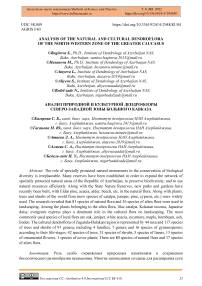Analysis of the natural and cultural dendroflora of the north-western zone of the Greater Caucasus
Автор: Bagirova Samira, Hasanova Minara, Atayeva Leila, Aliyeva S., Bedel-zade N.
Журнал: Бюллетень науки и практики @bulletennauki
Рубрика: Биологические науки
Статья в выпуске: 8 т.8, 2022 года.
Бесплатный доступ
The role of specially protected natural monuments in the conservation of biological diversity is irreplaceable. Many reserves have been established in order to expand the network of specially protected natural areas of the Republic of Azerbaijan, to preserve biodiversity, and to use natural resources efficiently. Along with the State Nature Reserves, new parks and gardens have recently been built, with Eldar pine, acacia, alder, beech, etc. in the natural flora. Along with plants, trees and shrubs of the world flora (new species of catalpa, juniper, pine, cypress, etc.) were widely used. The research revealed that 81 species of natural flora and 36 species of alien flora were used in landscaping. Among the plants belonging to the alien flora, lilac catalpa, Kokatan tecoma, Japanese daisy, evergreen cypress plays a dominant role in the cultural flora on landscaping. The most commonly used species of local flora are oak, juniper, white acacia, sycamore, maple, hornbeam, ash, linden. The cultural dendroflora of Zagatala-Balakan region is represented by 44 taxa and 117 species of trees and shrubs of 91 genera; including 4 families, 7 genera and 16 species of gymnosperms; according to their life-stages: 42 species of trees, 51 species of shrubs, 5 species of lianas, 13 species of ornamental flowers, 1 species of cover plants; There are 80 species of natural flora and 37 species of alien flora.
Biodiversity, nature reserves, relict species, endemic plants, cover plants, gymnosperms, life-stages
Короткий адрес: https://sciup.org/14125297
IDR: 14125297 | УДК: 58.009 | DOI: 10.33619/2414-2948/81/04
Текст научной статьи Analysis of the natural and cultural dendroflora of the north-western zone of the Greater Caucasus
Бюллетень науки и практики / Bulletin of Science and Practice
The main purpose of our research is to study and compare the taxonomic composition of newly built parks and gardens, green areas. The following is a brief description of the natural and cultural dendroflora of the regions. Gakh, Zagatala and Balakan, located in the north-western zone of the Greater Caucasus, have a special place due to their natural resources. Flora biodiversity includes mainly Caucasian, boreal, ancient, steppe and xerophytic flora elements. It is rich in relics and endemics of the Arctoalpine and Ice Ages, reflecting the characteristics of the forest, high mountain meadow regions of the Greater Caucasus. Trautvetter maple ( Acer trautvetteri Medw.), Nizami rose ( Rosa nisamii Sosn.), Azerbaijan rose ( Rosa azerbajdzhanica Novopokr. & Rzazade) and others. The climate of these regions is moderately hot and humid. The subtropical climate manifests itself [1–9].
In the territory of Balakan, Zagatala, Gakh regions, which are included in the north-western slope of the Greater Caucasus, the vegetation changes as it rises above sea level in accordance with the law of high zoning of mountainous areas. These areas include alder ( Alnus ), wingnut ( Pterocarya pterocarpa (Michx.) Kunth), poplar ( Populus hybrida M. Bieb . ), long-stemmed oak ( Quercus pedunculiflora K. Koch), juniper ( Juniperus ) sparse and partially Iberian pistachio. is coming. Iberian oak ( Quercus iberica Steven) and Carpinus caucasica Grossh. predominate in the low mountainforest belt of the mountainous zone at an altitude of 1000–1100 m above sea level. Oriental beech ( Fagus orientalis Lipsky), Caucasian oak ( Quercus macranthera Fisch. & C. A. Mey. ex Hohen.), Trautvetter maple ( Acer trautvetteri Medw.) and birch ( Betula ) forests in the mountain-forest zone of 1800–2000 m. In this zone, small areas of Caucasian rhododendron ( Rhododendron caucasicum Pall.), which is the only one for the territory of our republic, are found in the Zagatala reserve [8, 9].
In the mountainous part of the southern slopes of the Greater Caucasus, mainly beech ( Fagus ) 85.6 thousand ha, oak ( Quercu s) 45.6 thousand ha and hornbeam ( Carpinus ) 45.8 thousand ha are spread. Forest of other tree species (birch — Acer , elm — Ulmus , birch — Betula , walnut — Juglans ,
Бюллетень науки и практики / Bulletin of Science and Practice Т. 8. №8. 2022 chestnut — Castanea, Christ’s-thorn — Paliurus spina-christi, linden — Tilia, blackberry — Taxus baccata, Caucasian date — 81% lot) Diospyros, artificial trees make up only 19%. Pinus hamata (Steven) Fomin trees grow on the rocky passes and steep bare rocks at an altitude of 800–1000 m above sea level in the Filizchay (Balakenshay) basin on an area of about 10 hectares. These candles are relics of the ice age. In the territory of Gakh, Zagatala, Balakan districts, mainly oak-hornbeam and beech-hornbeam forests dominate. In the plain forests, apple (Malus Mill.), cherry plum (Prunus divaricata Ledeb.), maple (Acer caucasica L.), European ash (Fraxinus excelsior L.), hornbeam (Carpinus caucasica L.), jasmine (Syringa vulgaris L.), hawthorn (Crataegus L.), cornelian cherry (Cornus mas L.), Byzantine filbert (Corylus colurna L.), walnut (Juglans regia L.), oak (Quercus macranthera F.), willow (Salix L.), linden (Tilia R.), mulberry (Mespilus L.), European cranberrybush (Viburnum opulus L.), beech (Fagus orientalis), blackberry (Taxus baccata S. F. Gray) and others plants are also found. Cornelian cherry (Cornus mas L.) is more widespread along the slope in the protection zone. At the foot of the slope (at an altitude of 772 m above sea level, the common cornel is 2.4–6.0 m high, with a trunk diameter of 14–34 cm) is closely intertwined with other plants: hawthorn (Crataegus L.), apple (Malus Mill.), chestnut (Castanea sativa Mill.), oak (Quercus L.) and cherry plum (Prunus cerasifera Ehrh.).
The nature of Zagatala region is very rich. About half of the territory of Zagatala is covered by forests. The relief of the region is mountainous and plain. There are many forests in the region, but they are mainly located in the mountains and foothills. The flora of Zagatala region is rich in various valuable tree species. More than 900 plant species are distributed in Zagatala State Nature Reserve. 11 species of plants are included in the “Red Book” of the Republic of Azerbaijan due to their rarity and scarcity. Here grows a coniferous blackberry, a hooked pine tree and Caucasian rhododendron, which is unique to the flora of Azerbaijan and is of great scientific interest and belongs only to the Zagatala reserve [7].
Due to such richness of nature, Zagatala State Nature Reserve was established in 1930. Heydar Park, one of the recreation and tourism zones in Zagatala, was built in 1947 and covers an area of 13 hectares. There are 27 species of trees. The Balakan region is characterized by a humid subtropical and mountain-tundra climate. There are 4 climate zones in the region. It is temperate and semi-humid in the plains and foothills, cold and humid in the highlands. 65% of the region has a subtropical climate zone. Balaka’s rich forest cover makes up 5% of the country’s forest resources. In their forests, oak, hornbeam, beech, alder, acacia, etc. trees grow. 3/4 of the Zagatala reserve, the second largest in Azerbaijan, falls on the territory of Balakan region. Average temperature in January -1.5; -7.8 degrees, in July +10.5; +24.5 degrees. Annual precipitation ranges from 600 to 1400 mm. The maximum temperature is usually observed in July and can reach +37 degrees.
Gakh region is mainly known as the region of berries (hazelnuts, chestnuts, walnuts). Abundant water resources, normal moisture balance, fertile lands, forests, alpine and subalpine meadows, winter pastures ensure the development of agriculture and livestock. The region is one of the most important forest resources of the Republic. Oak, hornbeam, elm, walnut, chestnut, various fruit trees, medicinal plants are the rich resources of the forests here. In order to protect and increase this wealth, Ilisu State Nature Reserve was established. Most of the reserve falls on the village of Agchay [1, 2].
Material and methodology
The analysis of the life forms of trees and shrubs in the newly established parks and gardens, greenery in the studied areas was carried out according to the system of I. G. Serebryakov [10, 11], C. R. Raunkier [12].
Annual growth of old plants V. V. Smirnov, A. A. Molchanov [3], phenological observations were carried out according to generally accepted methods [2], the obtained results were analyzed. To assess the prospects of introducing plants, Sokolov S. Ya., Shishkin B. K. method [13], the indicators of plants in the new conditions were collected and the degree of perspective was determined [14 ]. In Gakh, Zagatala and Balakan regions, 4 species of trees and shrubs used in the newly established park and garden ecosystem, 16 species of 7 genera belong to gymnosperms, and 101 species of 84 genera belonging to 40 genera belong to 40 species, including 4 families and 10 genera of 10 species. The species belongs to the ornamental flowers. During the biomorphological analysis, it was found that 42 species of trees, 57 species of shrubs, 5 species of lianas, 2 species of lawns were used in the formation of the park-garden ecosystem in those areas (Table 1).
Table 1
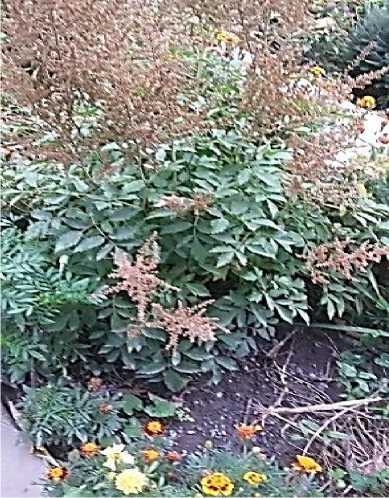
Figure 1. Nandina domestica Thunb. and Centranthus ruber (L.) DC.
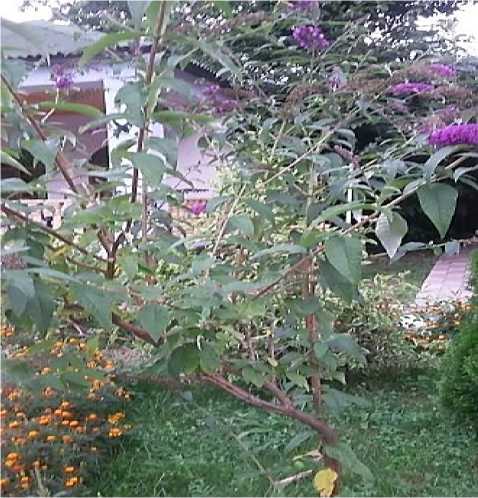
LIFE-STAGES OF PLANTS USED IN LANDSCAPING
|
Number of species |
Life-stages of plants |
|||
|
Tree |
Bush |
Lian |
Herbs |
|
|
117 |
42 |
57 |
5 |
13 |
The research revealed that 81 species of natural flora and 36 species of foreign flora were used in landscaping. Among the plants belonging to the foreign flora, lilac catalpa, Kokatan tecoma, Japanese daisy, evergreen cypress plays a dominant role in the cultural flora — landscaping. The most commonly used species of local flora are oak, juniper, white acacia, sycamore, maple, hornbeam, ash, linden (Table 2).
New species introduced during the study: Lagerstroemia indica L., Euonymus japonica L., Spiraea japonica L., Weigela florida (Bunge) A. DC., Photinia serrulata Lindl., Arbutus unedo L., Nandina domestica Thunb., Symphoricarpos albus (L.). S. F. Blake, Magnolia grandiflora L., Centranthus ruber (L.) DC. and so on. growth and development phases were compared with the conditions of Zagatala-Balakan region and Absheron and it was found that the stages of growth and phenological development of these species start 7–10 late in those regions compared to Absheron, annual growth is 10–12 cm more (Table 3, Figure 2).
Table 2
|
Family |
Genus |
Species |
|
|
Gymnosperms |
|||
|
Cupressaceae |
3 |
8 |
|
|
Pinaceae |
2 |
6 |
|
|
Taxodiaceae |
1 |
1 |
|
|
Taxaceae |
1 |
1 |
|
|
Angiosperms |
|||
|
Celastraceae |
1 |
1 |
|
|
Fagaceae |
1 |
4 |
|
|
Rosaceae |
3 |
5 |
|
|
Moraceae |
2 |
2 |
|
|
Aceraceae |
1 |
4 |
|
|
Oleaceae |
3 |
4 |
|
|
Asteraceae |
7 |
7 |
|
|
Buxaceae |
1 |
1 |
|
|
Arecaceae |
2 |
2 |
|
|
Tiliaceae |
1 |
1 |
|
|
Berberidaceae |
2 |
2 |
|
|
Leguminosae |
5 |
5 |
|
|
Caprifoliaceae |
4 |
6 |
|
|
Bignoniaceae |
2 |
2 |
|
|
Asparagaceae |
1 |
1 |
|
|
Ericaceae |
2 |
2 |
|
|
Platanaceae |
1 |
1 |
|
|
Betulaceae |
1 |
1 |
|
|
Cannaceae |
1 |
1 |
|
|
Vitaceae |
2 |
2 |
|
|
Malvaceae |
3 |
3 |
|
|
Salicaceae |
2 |
2 |
|
|
Magnoliaceae |
1 |
1 |
|
|
Lamiaceae |
1 |
1 |
|
|
Lamiaceae |
2 |
2 |
|
|
Ebenaceae |
1 |
2 |
|
|
Musaceae |
1 |
1 |
|
|
Juglandaceae |
2 |
2 |
|
|
Corylaceae |
2 |
3 |
|
|
Anacardiaceae |
2 |
2 |
|
|
Lauraceae |
1 |
1 |
|
|
Punicaceae |
1 |
1 |
|
|
Cornaceae |
1 |
1 |
|
|
Ulmaceae |
1 |
1 |
|
|
Agavaceae |
1 |
1 |
|
|
Euphorbiaceae |
1 |
1 |
|
|
Salicaceae |
1 |
1 |
|
TAXONOMIC COMPOSITION OF PLANTS USED
Бюллетень науки и практики / Bulletin of Science and Practice Т. 8. №8. 2022
|
Family |
Genus |
Species |
|
|
Hamamelidaceae |
1 |
1 |
|
|
Ranunculaceae |
1 |
1 |

|
COMPARATIVE ANALYSIS OF PHENOLOGICAL DEVELOPMENTAL STAGES OF SOME NEWLY INTRODUCED SPECIES |
Table 3 |
||||||
|
Species |
be s s ? |
be ■h к £ ^ < Й |
Flowering |
be |
|||
|
be к \3 «3 |
start |
end |
|||||
|
Lagerstroemia indica L. |
10.IV±8 |
03.V±8 |
08.VIII±5 |
15.VIII±5 |
25.VIII±4 |
28.IX±7 |
16,0 ±4 |
|
Euonymus japonicus Thunb. |
04.III±5 |
25.III.±5 |
12.IV±5 |
18.V±4 |
29.V±4 |
10.IX±6 |
11,0±5 |
|
Spiraea japonica L. f. |
10.IV±5 |
18.IV±5 |
15.VI±4 |
10.VII±4 |
30.VIII±3 |
18.X±4 |
9,5 ±4 |
|
Weigela florida (Bunge) A. DC. |
01.IV±8 |
16.IV±4 |
14.V±7 |
25.V±7 |
10.IX±6 |
05.X±5 |
12,5±8 |
|
Photinia serratifolia (Desf.) Kalkman |
30.III.±5 |
15.IV±3 |
19.IV±6 |
03.V±6 |
25.V±5 |
11.IX±5 |
17,0±5 |
|
Arbutus unedo L. |
02.IX.±8 |
07.IX±6 |
12.VII±6 |
24.IX±6 |
23.XII±5 |
10.VII±5 |
12,5±5 |
|
Symphoricarpos albus (L.) S.F. Blake |
01.IV±5 |
20.IV±5 |
05.V±5 |
25.V±5 |
14.VI±4 |
07.IX±4 |
7,0±4 |
|
Magnolia grandiflora L. |
27.III±8 |
15.IV±8 |
07.VI±6 |
27.VI±7 |
20.VIII±6 |
20.IX±6 |
37,0±5 |
|
Centranthus ruber (L.) DC. |
29.III±6 |
20.IV±5 |
25.V±5 |
10.VI±5 |
15.VIII±5 |
10.X±5 |
15,0±6 |
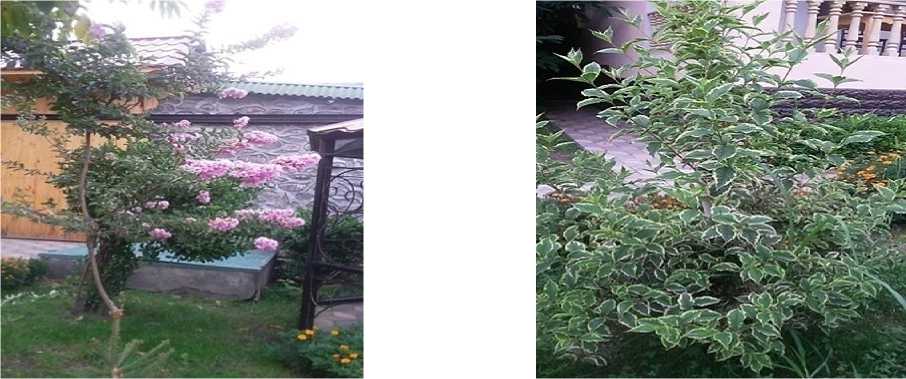
Figure 3. Lagerstroemia indica L. and Cornus mas L.
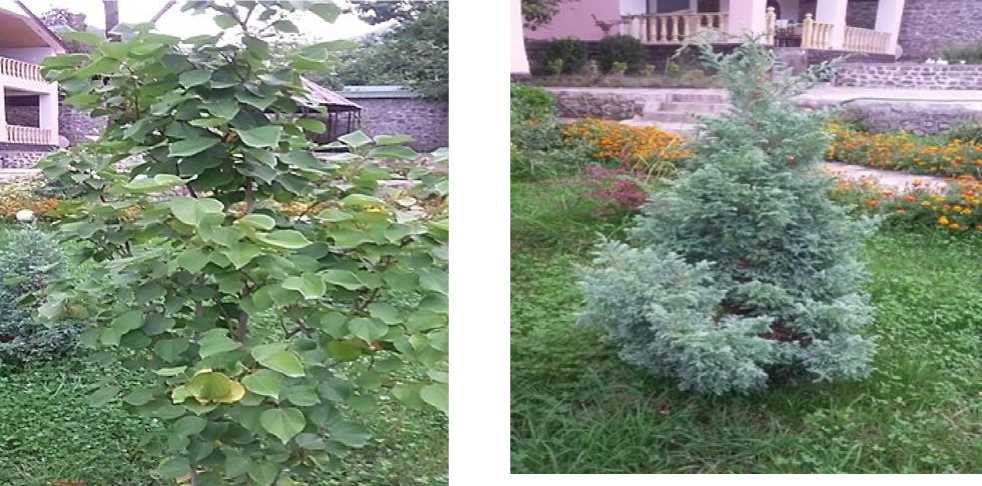
Figure 4. Actinidia chinensis Planch. and Juniperus scopulorum Sarg.
Conclusion
The cultural dendroflora of Zagatala-Balakan region is represented by 44 taxa and 117 species of trees and shrubs of 91 genera; including 4 families, 7 genera and 16 species of gymnosperms; according to their life forms: 42 species of trees, 51 species of shrubs, 5 species of lianas, 13 species of ornamental flowers, 1 species of lawn plants; There are 80 species of natural flora and 37 species of foreign flora.
Список литературы Analysis of the natural and cultural dendroflora of the north-western zone of the Greater Caucasus
- Mamedov, T. S. (2007). Entsiklopediya komnatnykh rastenii. Baku.
- Vasilchenko, I. T. (1979). Opredelitel' vskhodov sornykh rastenii. Leningrad. (in Russian).
- Molchanov, A. A., & Smirnov, V. V. (1967). Metodika izucheniya prirosta drevesnykh rastenii. Moscow. (in Russian).
- Beideman, I. N. (1974). Metodika izucheniya fenologii rastenii i rastitel'nykh soobshchestv. Novosibirsk. (in Russian).
- Zaitsev, G. N. (1981). Fenologiya drevesnykh rastenii. Moscow. (in Russian).
- Misnik, G. E. (1982). Kalendar' tsveteniya i plodonosheniya derev'ev i kustarnikov. Moscow. (in Russian).
- Volf, E. V., & Maleeva, O. F. (1968). Mirovye resursy poleznykh rastenii. Leningrad. (in Russian).
- Mamedov, T. S. (2011). Dendroflora Azerbaidzhana. II-III. Baku. (in Russian).
- Mamedov, T. S. (2010). Derev'ya i kustarniki Apsherona. Baku. 468 s.
- Serebryakov, I. G. (1952). Morfologiya vegetativnykh organov vysshikh rastenii. Moscow. (in Russian).
- Serebryakov, I. G. (1962). Zhivye formy vysshikh rastenii i ikh izuchenie. Polevaya geobotanika, 3. Moscow. (in Russian).
- Raunkiaer, C. (1934). The life forms of plants and statistical plant geography; being the collected papers of C. Raunkiaer. The life forms of plants and statistical plant geography; being the collected papers of C. Raunkiaer.
- Sokolov, S. Ya., & Shishkin, B. K. (1949-1965). Derev'ya i kustarniki SSSR: Dikorastushchie, kul'tiviruemye i perspektivnye dlya introduktsii. Moscow. (in Russian).
- Plotnikova, L. S. (1972). Metodika fenologicheskikh nablyudenii v botanicheskikh sadakh SSSR. Moscow. (in Russian).

